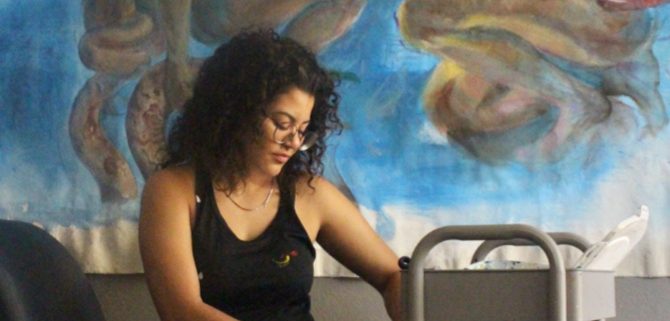Roski artist’s paintings pay homage to her Puerto Rican heritage

The walls of Marisol de la Garza’s room were covered with colorful tapestries. De la Garza, a junior majoring in art and cognitive science, put some final strokes of purple on a large portrait of a Puerto Rican deity. Something on the table felt slightly out of place in the apartment.
It was a dead beetle.
“As an artist, I try to pick up shiny and fluorescent bugs … which are always poisonous,” de la Garza explained with a laugh.
The beetle was a stunning shade of green that sparkled as it caught the light. It was strikingly beautiful. It is now a part of her exhibition titled “Colorín Colorado, este cuento no se ha acabado,” which will be on display at the Helen Lindhurst Fine Arts Gallery in Watt Hall. The show will run from Oct. 1 to 10, with a reception Oct. 3.
Beetles aside, de la Garza’s exhibition centers on her experience as a stateside Puerto Rican. Its main tenants are giant portraits of figures from Taino-Puerto Rican folklore. These deities are surrounded by vibrant indigenous animals, including leatherback turtles and iguanas.
“Fables were definitely a way that I’ve always connected,” de la Garza said. “My first impressions of Puerto Rico were these things my parents would talk about.”
De la Garza was born in Los Angeles and raised in San Antonio. Her grandparents are natives to Puerto Rico and help her maintain close ties to the island. Her family still has a small farm there.
Speaking on the effects of Hurricane Maria, de la Garza recounted how the devastating hurricane inspired her show and catalyzed her artistic process. She emphasized ecology and the environment as important themes in her work: Many of her pieces feature endangered species and highlight a message on the topic of conservation.
“Part of the discussion with colonialism [in Puerto Rico] is because industry really sacrifices the ecology,” de la Garza said. “And so that’s always something I’ve been sad about because they have such biodiversity there, and it’s just dwindling.”
With “Colorín Colorado,” de la Garza’s main goal is to spread awareness about the issues Puerto Rico faces, including climate change, poverty and the effects of colonialism. De la Garza said some of her inspiration comes from revolutionary colonial theorist Frantz Fanon.
“I wanted to bring all of those things that aren’t conveyed in the media at least to this institution,” de la Garza said. “Just bringing this into a gallery setting would be an accomplishment for me.”
De la Garza started out as a muralist. She stressed the sociopolitical aspects of murals and the importance of their accessibility. Remembering her work with murals and restoration, de la Garza emphasized that constructing and preserving murals is a highly collaborative effort. According to the Texas native, graffiti artists and local high schoolers would work with artists like herself to paint murals that would beautify neighborhoods and push back against gentrification.
De la Garza expressed gratitude for the opportunities made available to her at the Roski School of Art and Design. She said studying art in an academic setting has helped her refine her talents, giving her the tools to transition from a mural background to a more holistic artistic skill set. Most importantly, Roski has helped de la Garza’s work grow conceptually.
“I really wanted to be able to have, not an authority over art, but at least a voice in it … You have to be accredited and I wanted to learn the dialect and the writing skills that artists have to have,” de la Garza said. “Transitioning from a mural background to [a university setting] is not an opportunity many people get.”
Aside from the resources within Roski, de la Garza credits her roommate Erin Garcia with helping her work develop. Garcia, a junior majoring in fine art, serves as a sort of soundboard for de la Garza’s early concepts. When asked about what she looks forward to seeing in the exhibition, Garcia focused on the audience’s response.
“Not a lot of people have encountered this content before,” Garcia said. “I am excited to see how people will interact with it, if they’ll know what to do or what to think.”
Looking to the future, de la Garza wants to work at the intersection of arts and science, particularly in the field of animal behavior. But for now, she is happy with the opportunity this exhibition has presented to commemorate her Puerto Rican roots and bring her culture into the mainstream consciousness.
“I definitely just want people to raise awareness and show more concern,” de la Garza said. “That’s how I think this is trying to impact people psychologically.”

